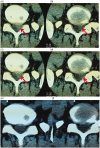Herniated disks unchanged over time: Size reduced after oxygen-ozone therapy
- PMID: 27066816
- PMCID: PMC4984384
- DOI: 10.1177/1591019916637356
Herniated disks unchanged over time: Size reduced after oxygen-ozone therapy
Abstract
The spontaneous regression of disk herniation secondary to dehydration is a much-debated topic in medicine. Some physicians wonder whether surgical removal of the extruded nucleus pulposus is really necessary when the spontaneous disappearance of a herniated lumbar disk is a well-known phenomenon. Unfortunately, without spontaneous regression, chronic pain leads to progressive disability for which surgery seems to be the only solution. In recent years, several studies have demonstrated the utility of oxygen-ozone therapy in the treatment of disk herniation, resulting in disk shrinkage. This retrospective study evaluates the outcomes of a series of patients with a history of herniated disks neuroradiologically unchanged in size for over two years, treated with oxygen-ozone therapy at our center over the last 15 years. We treated 96 patients, 84 (87.5%) presenting low back pain complicated or not by chronic sciatica. No drug therapy had yielded significant benefits. A number of specialists had been consulted in two or more years resulting in several neuroradiological scans prior to the decision to undertake oxygen-ozone therapy. Our study documents how ozone therapy for slipped disks "unchanged over time" solved the problem, with disk disruption or a significant reduction in the size of the prolapsed disk material extruded into the spinal canal.
Keywords: Lumbar disk herniation; ozone therapy.
© The Author(s) 2016.
Figures




References
-
- Bozzao A, Gallucci M, Masciocchi C, et al. Lumbar disk herniation: MR imaging assessment of natural history in patients treated without surgery. Radiology 1992; 185: 135–141. - PubMed
-
- Bozzao A, Gallucci M, Aprile I, et al. Evoluzione spontanea dell'ernia discale nei pazienti trattati con terapia non chirurgica. Riv Neuroradiol 1993; 6: 267–273.
-
- Davis RA. A long-term outcome analysis of 984 surgically treated herniated lumbar discs. J Neurosurg 1994; 80: 415–421. - PubMed
-
- Iliakis E, Valadakis V, Vynios DH, et al. Rationalization of the activity of medical ozone on intervertebral disc and histological and biochemical study. Riv Neuroradiol 2001; 14(Suppl. 1): 25–30.
-
- Kim KD, Kim ES. Spontaneous regression of herniated disc. Spine 2013; 38: 368. - PubMed
MeSH terms
Substances
LinkOut - more resources
Full Text Sources
Other Literature Sources
Medical

